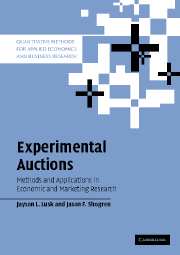Book contents
- Frontmatter
- Contents
- List of figures
- List of tables
- 1 Introduction
- 2 Incentive compatible auctions: theory and evidence
- 3 Value theory
- 4 Conducting experimental auctions: some preliminaries
- 5 Conducting experimental auctions
- 6 Data analysis
- 7 Valuation case studies
- 8 Auction design: case studies
- 9 Validity of experimental auctions
- 10 The future of experimental auctions
- References
- Index
2 - Incentive compatible auctions: theory and evidence
Published online by Cambridge University Press: 27 October 2009
- Frontmatter
- Contents
- List of figures
- List of tables
- 1 Introduction
- 2 Incentive compatible auctions: theory and evidence
- 3 Value theory
- 4 Conducting experimental auctions: some preliminaries
- 5 Conducting experimental auctions
- 6 Data analysis
- 7 Valuation case studies
- 8 Auction design: case studies
- 9 Validity of experimental auctions
- 10 The future of experimental auctions
- References
- Index
Summary
Introduction
Auctions have been used for centuries as a price-discovery mechanism (Lucking-Reiley, 2000). The theoretical study of auctions, however, is a relatively recent phenomenon. Starting with the pioneering work of William Vickrey in 1961, economists have developed a rich literature devoted to auction theory which is astounding in its results such as the revenue equivalence theorem and in its growing complexity. In addition to inventing and studying the properties of alternative auction mechanisms, theorists have addressed issues related to how bidding behavior is affected by numbers of bidders, information, value uncertainty, risk preferences, violations of expected utility theory, value interdependence, asymmetry, and multiple-unit demand. Good reference books and papers include: Klemperer (1999, 2004), Krishna (2002), Milgrom (2004), and McAfee and McMillan (1987). Such texts focus primarily on developing and espousing particular theoretical properties of auctions, with attention devoted to designing auctions for generating maximum possible revenue or efficiency (e.g., the ability of an auction to allocate units to the person or people with the highest value(s) for the auctioned good(s)). Students of experimental auctions should not by-pass this literature as it is important to understand such topics as revenue equivalence and efficiency.
Our book purposefully restricts the theoretical treatment of auctions to the question of incentive compatibility. An auction is said to be incentive compatible when it induces each bidder to submit a bid that sincerely reflects his or her value for the good.
- Type
- Chapter
- Information
- Experimental AuctionsMethods and Applications in Economic and Marketing Research, pp. 19 - 33Publisher: Cambridge University PressPrint publication year: 2007



